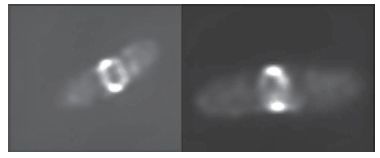
FtsZ Is Necessary for Septum Formation
 المؤلف:
JOCELYN E. KREBS, ELLIOTT S. GOLDSTEIN and STEPHEN T. KILPATRICK
المؤلف:
JOCELYN E. KREBS, ELLIOTT S. GOLDSTEIN and STEPHEN T. KILPATRICK
 المصدر:
LEWIN’S GENES XII
المصدر:
LEWIN’S GENES XII
 الجزء والصفحة:
الجزء والصفحة:
 30-3-2021
30-3-2021
 1989
1989
FtsZ Is Necessary for Septum Formation
KEY CONCEPTS
-The product of ftsZ is required for septum formation.
-FtsZ is a GTPase that resembles tubulin, and polymerizes to form a ring on the inside of the bacterial envelope. It is required to recruit the enzymes needed to form the septum.
The gene ftsZ plays a central role in division. Mutations in ftsZ block septum formation and generate filaments. Overexpression induces minicells by causing an increased number of septation events per unit cell mass. FtsZ (the protein) recruits a battery of cell division proteins that are responsible for synthesis of the new septum.
FtsZ functions at an early stage of septum formation. Early in the division cycle, FtsZ is localized throughout the cytoplasm, but prior to cell division FtsZ becomes localized in a ring around the circumference at the mid-cell position. The structure is called the Zring, which is shown in FIGURE 1. The formation of the Z-ring is the rate-limiting step in septum formation, and its assembly defines the position of the septum. In a typical division cycle, it forms in the center of the cell 1 to 5 minutes after division, remains for 15 minutes, and then quickly constricts to pinch the cell into two.

FIGURE 1. Immunofluorescence with an antibody against FtsZ shows that it is localized at the mid-cell.
Photo courtesy of William Margolin, University of Texas Medical School at Houston.
The structure of FtsZ resembles tubulin, suggesting that assembly of the ring could resemble the formation of microtubules in eukaryotic cells. FtsZ has GTPase activity, and GTP cleavage is used to support the oligomerization of FtsZ monomers into the ring structure. The Z-ring is a dynamic structure, in which there is continuous exchange of subunits with a cytoplasmic pool.
Two other proteins needed for division, ZipA and FtsA, interact directly and independently with FtsZ. ZipA is an integral membrane protein that is located in the inner bacterial membrane. It provides the means for linking FtsZ to the membrane. FtsA is a cytosolic protein, but is often found associated with the membrane. The Zring can form in the absence of either ZipA or FtsA, but it cannot form if both are absent. Both are needed for subsequent steps. This suggests that they have overlapping roles in stabilizing the Zring and perhaps in linking it to the membrane. The products of several other fts genes join the Z-ring in a defined
order after FtsA has been incorporated. They are all transmembrane proteins. The final structure is sometimes called the septal ring. It consists of a multiprotein complex that is presumed to have the ability to constrict the membrane. One of the last components to be incorporated into the septal ring is FtsW, which is a protein belonging to the SEDS family. The ftsW gene is expressed as part of an operon with ftsI, which encodes a transpeptidase (also called PBP3 for penicillin-binding protein 3), a membrane-bound protein that has its catalytic site in the periplasm.
FtsW is responsible for incorporating FtsI into the septal ring. This suggests a model for septum formation in which the transpeptidase activity then causes the peptidoglycan to grow inward, thus pushing the inner membrane and pulling the outer membrane.
 الاكثر قراءة في مواضيع عامة في الاحياء الجزيئي
الاكثر قراءة في مواضيع عامة في الاحياء الجزيئي
 اخر الاخبار
اخر الاخبار
اخبار العتبة العباسية المقدسة


